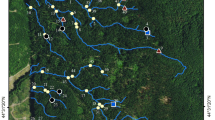Abstract
A quantitative evaluation of stream temperature alterations due to a commercial forest harvesting practice and a research treatment is presented. Summer maximum stream temperatures averaged 1 ° C higher in the commercial clearcut and 9 °C higher in the clearcut-herbicided watershed than in the forested control. The largest average monthly temperature increase on the commercial clearcut (2.2 °C) occurred during April; on the clearcut-herbicided basin it occurred during June (10.5 °C). Significant changes in stream temperature were observed on both watersheds as early as February and as late as November.
Changes in minimum stream temperatures are presented in detail along with the impact on diel temperature fluctuations. Changes in the stream temperature regimes of the clearcut watersheds from the headwaters to the mouth of the watersheds are also given. Potential impacts of the stream temperature alterations on aquatic ecosystems are summarized in relation to stress limits for brook trout and other organisms.
Similar content being viewed by others
References
Anderson, H. W., 1973. The effects of clearcutting on stream temperature: a literature review. DNR Rep. 29. Wash. Dep. nat. Resour., Olympia, Wash., 24 pp.
Aubertin, G. M. & J. H. Patric, 1974. Water quality after clearcutting a small watershed in West Virginia. J. envir. Qual. 3: 243–249.
Bardach, J. E. & R. G. Bjorklund, 1957. The temperature sensitivity of some American freshwater fishes. Am. Nat. 91: 233–251.
Brett, J.R., 1956. Some principles in the thermal requirements of fishes. Q. Rev. Biol. 31: 75–87.
Brown, G. W. & J. T. Krygier, 1967. Changing water temperature in small mountain streams. J. Soil Wat. Conserv. 22: 242–244.
Burns, J. W., 1972. Some effects of logging and associated road construction on northern California streams. Trans. am. Fish. Soc. 101: 1–17.
Cairns, J., Jr., 1970. Ecological management problems caused by heated waste water discharged into the aquatic environment. Wat. Resour. Bull. 6: 868–878.
Chapman, D. W., 1962. Effects of logging upon fish resources of the West Coast. J. For. 60: 533–537.
Chapman, D. W. & R. L. Demory, 1963. Seasonal changes in food ingested by aquatic insect larvae and nymphs in two Oregon streams. Ecology 14: 140–146.
Fry, F. E. J., 1947. Effects of the environment on animal activity. Univ. Toronto Stud., Biol. Ser. 55, Publ. Ont. Res. Lab. 68: 5–62.
Fry, F. E. J., 1951. Some environmental relations of the speckled trout (Salvelinus fontinalis). Proc. NE. Atlantic Fish. Conf. (mimeo).
Hesser R., R. Hoopes, C. B. Weirich, J. Selcher, B. Hollender & R. Snyder, 1975. The aquatic biota. In: Clearcutting in Pennsylvania. Sch. For. Resour., Coll. Agric., Pa. St. Univ., Univ. Park: 9–20.
Holt, C. S. & T. F. Waters, 1967. Effect of light intensity on the drift of stream invertebrates. Ecology 48: 225–233.
Lagler, K. F., J. E. Bardach & R. R. Miller, 1962. Ichthyology. John Wiley & Sons, Inc., N.Y., 545 pp.
Lynch, J. A., E. S. Corbett & R. Hoopes, 1979. Implications of forest management practices on the aquatic environment. Fisheries 2: 16–23.
Meehan, W. R., 1970. Some effects of shade cover on stream temperature in southeast Alaska. Pac. N.W. Forest & Range Exp. Stat., Forest Serv. USDA Res. Note PNW-113, 9 pp.
Narver, D. W., 1971. Effects of logging debris on fish production. In: Proc. of a Symposium on Forest Land Use and the Stream Environment. Oregon St. Univ., Corvallis. Oct. 19–21, 1970: 100–111.
Nebecker, A. V., 1972. Effect of low oxygen concentrations on survival and emergence of aquatic insects. Trans. am. Fish. Soc. 101: 675–679.
Ordal, E. J. & R. E. Pacha, 1963. The effects of temperature on disease in fish. In: Water temperature influences, effects, and control. Proc. 12th Pacific Northwest Symposium on Water Pollution Research, U.S. Public Health Serv., Pacif. NW. Wat. Lab., Corvallis, Oreg., 39–56.
Wojjalik, T. A. & T. F. Waters, 1970. Some effects of heated water on the drift of two species of stream invertebrates. Trans. am. Fish. Soc. 99: 782.
Additional information
School of Forest Resources, Pennsylvania State University, University Park, PA 16802, U.S.A.
USDA Forest Service, Northeastern Forest Experiment Station, University Park, PA 16802, U.S.A.
Rights and permissions
About this article
Cite this article
Lynch, J.A., Rishel, G.B. & Corbett, E.S. Thermal alteration of streams draining clearcut watersheds: Quantification and biological implications. Hydrobiologia 111, 161–169 (1984). https://doi.org/10.1007/BF00007195
Received:
Accepted:
Issue Date:
DOI: https://doi.org/10.1007/BF00007195




